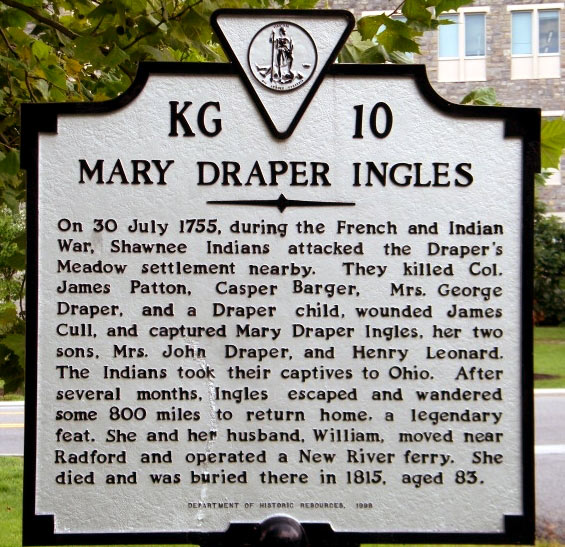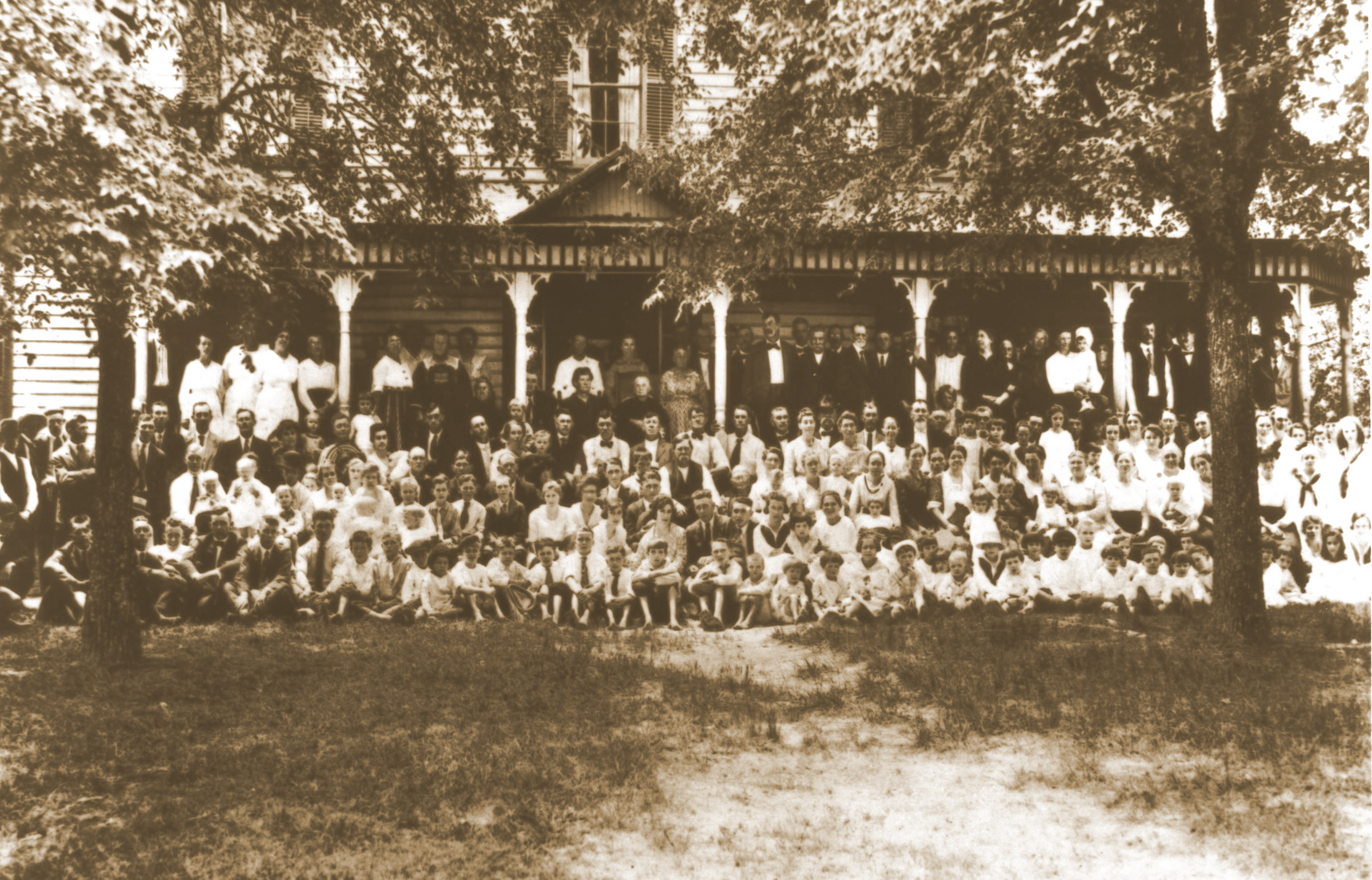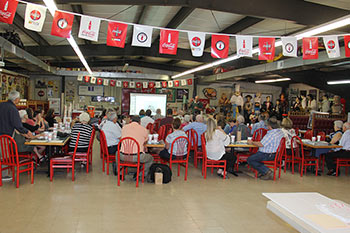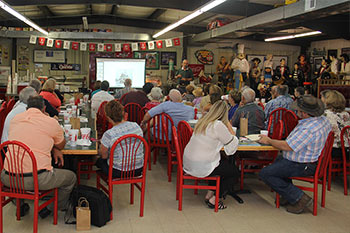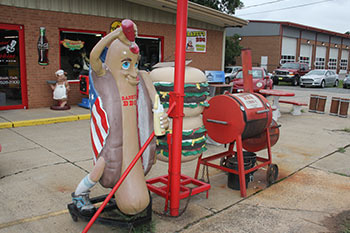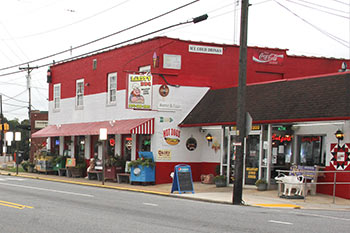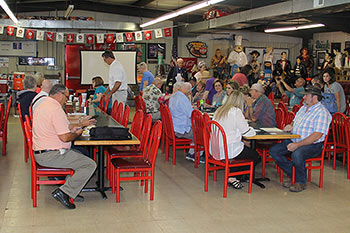CHAPTER 14
The Saga of William, the First Lippard Pioneer, Draper's Meadow
The great American legend that the real pioneers went somewhere where they could not see the smoke of their neighbor's fires seldom was true; yet in the case of William Lippard. it came close.
As Conrad implied in his will—where William is not one of the executors—portions of his family had moved away. For decades, Harriet, Seth, and Gary could not figure out what had happened. There was a decade long gap between the last church record from Pennsylvania and the first land deed in North Carolina. The easiest explanation was that Wilhelm's family were squatters and simply farmed land they did not own for years. Two discoveries made in the early 2000s helped Gary understand the falsity of this idea.
First, North Carolina politics of that time made hiding in the woods impossible, given the fights over taxation and public obligations connected to the great colonial dispute called the Revolution. William, and then John, show up in the court records of Rowan County, even though they don't own land—it seems—and they don't actually live in Rowan County. There seemed to be a major gap and little fit to the data.
Second, Gary had a fellow local historian tell him that future Cabarrus County residents were living on the New River in Virginia in the 1750s, and Lippards were among them. Then, the historian lost that source, and Gary did not have good access to Virginia records at that time. That was all we had at the reunion for the John generation when we went to Rowan County for the reunion in 2014.
Then, in 2018 and 2019 Harriet was able to sort and scourge through the World Wide Web in ways that were not available just a few years ago. This is particularly the case with material scanned into Google Books. With the help of Carla Goodloe of California, who was doing family research, we relocated William, and we found him in Virginia, and we found a lot more than we thought we ever would. Carla sent Harriet a scan of a small piece of paper. William in 1753 had been appointed an overseer of a road near today's Blacksburg, Virginia.
William and family sometime after 1751—when they appeared last in the records of Faulkner Swamp church--had moved west and south along that Great Wagon Road. In fact, he had gone beyond where the wagons could safely be taken, the current city of Staunton, and he had gone fifty miles further down the Great Valley of Virginia to where the city of Blacksburg, Virginia, is today.
Blacksburg is home to Virginia Tech University, and William seems to have owned at least 620 acres there, though the deed says "on Tom's Creek" a little farther to the west. The land he owned would eventually become the home to the Black family that gave the city its name.
In some way, William had the wherewithal, capital, etc., to gain this property, and it appears that he was a respected member of this pioneer community. More than once he appears as a road overseer—actually a very important community responsibility in that day—for the spur of the Great Wagon Road that leads from the New River across a ridge to the watershed of the Roanoke River's north fork. This stretch of the road led from the Cherokee lands to the southwest to the fork at the future site of the city of Roanoke, Virginia. The southeastern spur there after 1754 became the Carolina Road that led the way to Wachovia in North Carolina. That can be seen in the excerpts shown here of the map of Virginia drawn by Peter Jefferson. Yes, he was the father of the Founder, Thomas Jefferson.
This particular wide-out between mountain ridges was at the time known as Draper's Meadow, an indication that there was open prairie in parts of it. It would have been a logical stopping place for William for two reasons: 1) its remoteness meant land was very cheap (although we cannot confirm this with the scanty details we have), and 2) William must have thought that either the meadows or the proximity to the branches of the great road would benefit his future well-being. (It should be pointed out that he was in his fifties by this time, and it could have been that he was trying to "set up" his sons with land of their own, land that would have been at a premium in Pennsylvania.)
William was not the first European to settle the area. Local legend says that the Drapers, Ingles, and other families from the British Isles had been there since the 1740's. The first cluster of land deeds issued by the British officials in Williamsburg date to February 1753, and William—oddly, Gary thinks—got some premium land the next month, in March 1753. Either way, he was set up in a new community, where he had status.
And, ethnic connections. He may have stopped there because there were other Germans in the area, including a colony of those Tumblers—i.e., Dunkers—who planted by the signs nude to be able to absorb the energy of the full moon and bear it into the seeds. (They would be persecuted in Virginia and North Carolina, and modify their ways.) There were people named Leonard and Harmon, both names that would reappear in North Carolina neighborhoods later. Most importantly, was the presence of a Casper Barger, who had emigrated to Philadelphia on a different ship in September 1738, and may have known the Lippards. Barger took up land on the New River at the same time as William.
Then disaster struck many of them. The Great Wagon Road had originally been a single file track known as the Warriors' Path, a route dedicated to the spoils of war among aboriginal groups. For example, the Catawba in South Carolina carried on an intermittent feud with Iroquois interests in New York, and it was common in warm weather to see war parties loping more than 1,000 miles just for "coup", the snatch of a scalp or the body of a prisoner being taken to be sacrificed back home. Given that the road was designed for warfare, one Virginia historian has wondered what these white settlers were thinking! They were at the crossroads of both tribal contentions and international intrigue. The year after William Lippard got the deed to his land, the French and Indian War began, and no one—red, white, or black—along the whole American frontier was safe.
One of the belligerents was the Shawnee, once residents of the Atlantic Coast, but pushed back into the Ohio River area by the expansion of Eurocentric settlement. The Shawnee used the area around Draper's Meadow as a way station on their jaunts to collect coup, and with a war that put them on the French side, British scalps were at a premium.
What became the Massacre at Draper's Meadow occurred sometime during July 1755, just weeks after the British had met disaster in the woods near today's Pittsburgh. The near annihilation of an Anglo-American army—George Washington had managed the retreat of the survivors, and Daniel Boone had been one of the first to flee the scene, most likely taking the Great Wagon Road home—had encouraged strikes along the frontier from Pennsylvania to South Carolina.
The Shawnee came along the southwestern spur and seemed to focus on the leading British Isles settlers, including the original land holder, Colonel James Patton. Five were killed outright—including Casper Barger—and five more were taken hostage and taken back to the villages on the Ohio to replenish the tribal population. Houses were burned, crops destroyed, and hostages taken. Two of the men taken back were from the German part of the neighborhood.
The whole community. where the Shawnee burned down almost all of the cabins, was abandoned, and in the flight, the Lippards seem to have gone to North Carolina. There is no evidence to suggest that the Lippards were attacked that day, although there remain questions about certain of William and Catherine's children that go unanswered. It is not clear how many children died in the attack, so it is possible that some Lippards were lost that day.
The Draper's Meadow massacre has been the subject of both a recent novel and a movie that focus—on the escape of one of the victims from Native American captivity.
Novelist James Thom, who has studied the incident, wrote Harriet in February 2019 with some suggestions as to what might have happened:
The Lippards, according to Thom, may "have got by unharmed because the Shawnee raiders were a very small party, probably sixteen to twenty in number, intent on getting in and out hastily. . . Just being on the other side of a hill or a creek could determine our fate." By his estimate the Lippards would have been among the dozen or so families spared in the ordeal, while a half dozen in specific places suffered. There is even the possibility that the Lippards were spared on purpose. A tradition in the Barger family is that Casper Barger was decapitated by the raiders, his head put in a bag, and it was brought to the door of a neighbor as an example. Since Barger's land abutted that of William Lippard', perhaps a Lippard was the recipient.
William does appear back in the area, when he is recalled to settle some accounts. He was listed as a debtor in a 1758 probate account, and received payment with a 1763 settlement. As late as 1769 he was listed as an outstanding debtor in the estate of Colonel James Patton, one of the massacre victims. His land, moreover, is not bought by the Black family until the 1770s, but it is not clear that William had ever paid for it, or just let it go and lost his initial payment. He never pays taxes on it, as far as we can tell.
What I Know About the Wm. Lippard Family and the Draper's Meadow Indian Massacre
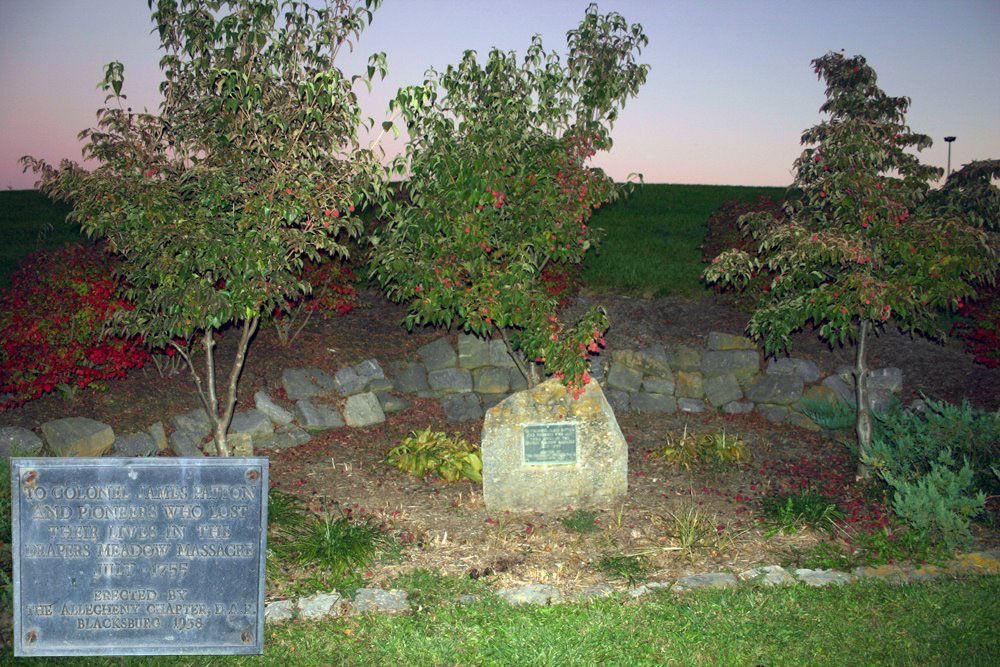
Memorial Marker located on the Virginia Tech Campus Commemorating the Draper's Meadow Massacre of 1755
Many years ago Gary Freeze was told by another American historian that he had been doing some research in southern Virginia and came upon the name Lippard. Unfortunately, he could not remember the man's first name nor the Virginia county in which he was doing research when he saw the Lippard name. Gary and Harriet did a little searching, but after finding nothing, gave up the idea that our Lippard family might have stopped for a few years in the Shenandoah Valley because Indian raids were beginning to occur by 1754, and by 1755 full-blown war (The French and Indian War) including many Indian massacres continued until the French and Indians surrender in 1763.
Harriet had been trading some Lippard family information with Carla Goodloe of California when one day Carla sent several items of interest including a scan of a small piece of paper saying that William Lippard had been appointed overseer of a road in the Blacksburg area of Virginia in 1754. At last we had a clue validating the idea that William and his family spent a few years in Virginia. We learned among other details from Chalkley's Chronicles, "Early Settlers of Old Augusta County, Virginia," p.48, that William had selected a 620 acre plot of land plus an additional 75 acres along Tom's Creek on the northern border of Draper's Meadows (near present day Blacksburg) and purchased it on 21 March 1754 from Colonel James Patton. It abutted Captain Barrier (Barger's) land with the New River being on the west. The neighbor family on the other side was the Scots-Irish family of William Ingles. The site of this small twenty family community of Scots-Irish and German settlers is now in the heart of the Virginia Tech College campus. However, it became apparent that by 1755 for lack of mention of them, that the Lippards had left the settlement by 1755. Why, we puzzled, would the Lippard family leave the fertile 620 acres plus then an additional 75 acres in Virginia for the 188 acres they selected in North Carolina?

Memorial Wall located on the Virginia Tech Campus Commemorating the Draper's Meadow Massacre of 1755
When we "googled" Draper's Meadow, we were horrified to see the names of articles including one from Wikipedia entitled essentially "Draper's Meadows Massacre, July 8 or 30, 1755. Were any of our family killed or captured when a sizable band of Shawnee Indians entered the sparsely populated camp unimpeded and killed eight or more people, captured five or six other settlers, wounded a few more, and marched those who could walk back to the Shawnee camps in either Kentucky or Ohio? Overcome by sadness, panic, and horror, the remaining settlers fled for their lives. Both of the Lippard's immediate neighbors suffered either loss by death or captivity of some of their family members. The Indians burned the entire settlement. No mention of Lippards is made in the perhaps not complete lists of killed, wounded, and captured, but we do have concern about the other children except for Johannes who obviously escaped and survived. Evidently the dead were hastily buried on what is now the Virginia Tech campus near the Duck Pond before the survivors fled. Later a commemorative wall and sign were erected to mark the grave trench of the bodies of those killed. So recall that we are not certain that James and Robert belong to our family. Some of the other children seem to have been lost in Pennsylvania or Virginia. Did we lose any of Catherina and Wilhelm's children in the Draper's Meadows Indian massacre? Johannes obviously was safe, but we were unable to find any more recent sourced information concerning Christian, Magdalena, Anna Catherina and the two boys James and Robert who may belong to our family. As it turned out, we found Christian in South Carolina in the Militia fighting in the Cherokee Indian War. How did at least some of our family manage to escape when tragedy struck the farms on either side of them? Imagine the fear and horror as they and other Draper's Meadows' families mourned the dead, wounded, and captured as they fled for their lives.
So far as we know this Draper's Meadow event was never passed down through the branches of our family but evidently was kept a secret too traumatic to discuss. And as we shall see at least William seemed to go through a serious post-traumatic stress disorder. Unfortunately, we know nothing about how Catherina coped with whatever had happened to their family.
Today, there is little trace of the massacre other than a marker commemorating the massacre located near the Duck Pond and an engraved wall marking the burial place of the victims, both on the Virginia Tech campus.
It is possible that the Lippards knew the Bargers from Germany, Rotterdam, and/or Pennsylvania. Both families arrived in Philadelphia from Rotterdam in September 1738. They arrived on sister ships belonging to the Hope Company of England, the Lippards on the Queen Elizabeth and the Bargers on the Winter Galley. Both settled initially in the Perkiomen Valley, Hanover township, Philadelphia County, Pennsylvania (Pennsylvania Census and Voters' List, 1700's, and Pennsylvania Early Census Index). So far we have been unable to connect the Casper Barger family to the Barger (Berger, Barrier) family of Piedmont North Carolina who later marry into the Lippard family.
